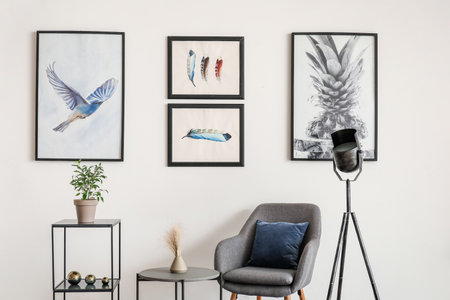1. Introduction to Feng Shui in American Living Rooms
Feng Shui, an ancient Chinese practice, focuses on creating harmony and balance within a space. While its roots are deeply traditional, Feng Shui has found a welcoming home in the United States, especially as more Americans look for ways to make their living rooms both beautiful and comfortable. Adapting Feng Shui principles to modern American homes doesn’t require following strict rules; instead, it’s about blending these ideas with your personal style and local culture.
In the U.S., living rooms serve as gathering spots for family, friends, and relaxation. They often reflect individual tastes, from cozy farmhouse vibes to sleek urban minimalism. The good news is that Feng Shui can enhance any of these styles by focusing on energy flow (chi), functional layouts, and mindful décor choices. By understanding a few core concepts, you can bring positive energy into your living room without sacrificing comfort or personality.
Why Try Feng Shui in Your Living Room?
- Boost Comfort: Arranging furniture for better energy flow can make your space feel more inviting.
- Encourage Connection: Thoughtful layouts support easier conversations and gatherings.
- Promote Well-being: Good Feng Shui is believed to reduce stress and create a calming atmosphere.
Core Feng Shui Principles Adapted for U.S. Homes
| Feng Shui Principle | How It Fits American Living Rooms |
|---|---|
| Clear Entryway | Keep the main entrance free of clutter so guests feel welcome right away. |
| Balanced Layout | Avoid pushing all furniture against walls; arrange seating to encourage conversation. |
| Natural Elements | Add plants, wood accents, or natural light to connect with nature indoors. |
| Personal Touches | Meld family photos and art with harmonious colors for unique yet balanced décor. |
| No Sharp Corners | Soften edges with round tables or plush pillows to improve energy flow and safety. |
Cultural Blend: East Meets West at Home
The beauty of applying Feng Shui in the United States lies in flexibility. You don’t have to give up your favorite American traditions or design trends—Feng Shui works best when it supports your lifestyle. Whether you love mid-century modern pieces or rustic barnwood shelves, you can use simple Feng Shui ideas to boost comfort, harmony, and style in your living room.
2. Furniture Placement: Do’s and Don’ts
Why Furniture Placement Matters in Feng Shui
Furniture arrangement is key to good Feng Shui, especially in American living rooms where open concepts and social gatherings are common. The way you set up your sofas, chairs, and tables can impact the flow of energy (chi), comfort, and how easily friends and family connect.
Sofas and Seating: Do’s and Don’ts
| Do | Don’t |
|---|---|
| Place the main sofa against a solid wall for stability and support. | Avoid floating the sofa in the middle with no support behind it. |
| Arrange seating in a U-shape or semi-circle to encourage conversation. | Don’t line up all chairs along one wall—this blocks social interaction. |
| Keep pathways clear for easy movement and energy flow. | Don’t block doorways or windows with bulky furniture. |
| Choose comfortable, inviting seating to make guests feel at home. | Don’t overcrowd the room with too many chairs or oversized couches. |
The Command Position for Sofas
In Feng Shui, the “command position” means placing your main sofa so you can see the entryway without being directly in line with it. In American homes, this often means angling the couch slightly or positioning it so you have a clear view of who enters, which adds both security and sociability.
Coffee Tables & Side Tables: Smart Placement Tips
- Do: Use rounded or oval coffee tables to soften energy flow. This is safer for kids and feels more welcoming in casual U.S. homes.
- Don’t: Use sharp-cornered tables that point toward seating areas—they create harsh energy (“poison arrows”).
- Do: Place side tables within easy reach of seats for drinks, books, or remotes—making gatherings more comfortable.
- Don’t: Cram tables into tight spaces where people may bump into them.
Sociability & Comfort: American Living Room Priorities
A well-arranged living room supports both everyday relaxation and social events—from watching football games to holiday parties. Remember these quick tips:
- Keep furniture proportional to your space—big sectionals work for large open-plan homes, while smaller sofas fit cozy apartments.
- Add soft throws or pillows to make seating extra inviting.
- Avoid putting furniture directly under exposed beams—this can cause uneasy feelings according to Feng Shui wisdom.
Your Living Room, Your Energy Flow
The best Feng Shui arrangement is one that feels good for you and your family while supporting comfort, positive vibes, and togetherness in your American home setting.

3. Choosing Colors and Materials
When decorating your living room in the United States with Feng Shui principles, it’s important to pick colors and materials that foster harmony and balance. The right choices can make your space feel inviting while also fitting popular American design trends.
Understanding Feng Shui Color Palettes
In Feng Shui, colors represent different elements—wood, fire, earth, metal, and water—and each one affects the energy in a room. Here’s a quick guide to some popular colors and their effects, with examples that match American style:
| Color | Feng Shui Element | Effect | American-Friendly Examples |
|---|---|---|---|
| Light Blue | Water | Calming, peaceful energy | Pale blue accent walls, throw pillows |
| Earthy Beige/Tan | Earth | Stability and comfort | Neutral sofas, area rugs, wall paint |
| Sage Green | Wood | Growth and renewal | Sage green plants, cushions, art prints |
| Soft White/Cream | Metal | Clarity and openness | Creamy walls, white trim, minimalist décor |
| Pops of Red or Orange | Fire | Warmth and energy (use sparingly) | Red vases, orange artwork, small decor pieces |
Selecting Materials for Balance and Style
The materials you choose also impact the Feng Shui of your living room. In American homes, mixing natural textures with modern touches is both trendy and harmonious.
Feng Shui Dos:
- Use Natural Materials: Wood coffee tables, bamboo shades, cotton or linen upholstery create warmth and connection to nature.
- Add Metal Accents: Think brass lamps or steel picture frames for clarity and crispness.
- Incorporate Glass: Glass tabletops or vases help energy flow smoothly through the space.
- Mimic Nature: Stone coasters or ceramic planters add an earthy vibe.
Feng Shui Donts:
- Avoid Overly Dark Colors: Too much black or deep brown can make the space feel heavy or closed off.
- No Cluttered Surfaces: Keep shelves and tables tidy so energy doesn’t get stuck.
- Limit Synthetic Materials: Plastic furniture or overly shiny surfaces may disrupt the natural balance.
- No Sharp Edges Facing Seating Areas: Choose rounded corners on tables when possible for a softer feel.
Quick Reference: Feng Shui Color & Material Matches for U.S. Living Rooms
| Element/Effect Needed | Best Color Choices | Ideal Materials & Decor Ideas |
|---|---|---|
| Relaxation & Calm | Light blue, soft gray | Linen drapes, cotton throws |
| Energy & Warmth | Red accents, warm beige | Wood frames, red cushions |
| Balance & Grounding | Earth tones (tan, brown) | Stone coasters, clay pots |
Tasteful Touches for American Homes:
- Add indoor plants (like a snake plant or pothos) for vibrant wood energy.
- Mix cozy textiles (chunky knit blankets) with sleek metal lamp bases for visual balance.
- If you love bold color trends (navy blue sofas or emerald green chairs), soften them with neutral accents to keep good Feng Shui flow.
The right colors and materials don’t just look great—they make your living room feel like home while enhancing positive energy according to Feng Shui principles tailored for American lifestyles.
4. Lighting and Natural Elements
In American homes, the living room is often the heart of the house, where family and friends gather. According to Feng Shui, bringing in natural light and elements can boost energy, comfort, and harmony. Here’s how you can maximize these benefits while staying true to modern American style.
Maximizing Natural Light
Natural light is a key element in Feng Shui because it invites positive energy (chi) into your home. Try these simple tips:
- Keep windows clean: Dusty windows block sunlight and chi. Regularly wipe them down for clarity and brightness.
- Use sheer curtains: Choose light-filtering or sheer fabrics that let sunshine in but still provide privacy.
- Strategic furniture placement: Avoid placing bulky furniture directly in front of windows so light flows freely throughout the space.
Bringing Nature Indoors with Plants
Plants are a popular decor choice in the U.S., and they’re perfect for balancing living room energy. They represent growth and vitality in Feng Shui. Here’s a quick guide to selecting plants:
| Plant Type | Feng Shui Benefit | American Style Tip |
|---|---|---|
| Pothos or Snake Plant | Cleans air, easy care | Great for shelves or corners |
| Bamboo | Attracts luck and prosperity | Adds a modern touch to side tables |
| Peace Lily | Promotes calmness, purifies air | Lovely as a statement piece on coffee tables |
| Aloe Vera | Healing energy, absorbs negativity | Suits contemporary or rustic decor styles |
Eco-Friendly Decor Choices
Sustainability is a growing trend across the United States. Incorporating eco-friendly pieces aligns well with Feng Shui principles by respecting nature and promoting balance. Consider these ideas:
- Select reclaimed wood furniture: Adds warmth, character, and supports environmental responsibility.
- Choose non-toxic paints and finishes: Keeps your living space healthy for everyone.
- Add organic cotton or wool throws: These materials feel cozy and contribute to a balanced atmosphere.
Quick Do’s & Don’ts for Lighting & Natural Elements
| Do’s | Don’ts |
|---|---|
| Let in plenty of daylight Decorate with healthy green plants Use natural materials whenever possible |
Block windows with heavy drapes or clutter Place fake or dying plants Overuse synthetic decor items that disrupt harmony |
Create Your Inviting Space
A well-lit living room filled with natural elements not only follows Feng Shui but also creates an inviting environment—perfect for relaxing or entertaining guests, American style!
5. Common Mistakes to Avoid in Feng Shui Living Room Decor
Clutter: The Biggest Feng Shui No-No
One of the most common mistakes in American living rooms is letting clutter build up. In Feng Shui, clutter blocks the flow of positive energy (Chi), making your space feel cramped and stressful. Everyday items like magazines, shoes, toys, or unused furniture can easily pile up.
| Clutter Source | How to Fix It |
|---|---|
| Coffee tables overloaded with items | Use baskets or trays to organize remotes and magazines. Keep only essentials on display. |
| Shoes and bags near the entrance | Add a shoe rack or storage bench by the door to keep entryways tidy. |
| Toys scattered around | Designate a storage box or basket for quick clean-ups. |
| Old newspapers and mail | Create a mail station or recycle papers weekly. |
Misplaced Electronics and Gadgets
Televisions, gaming consoles, and even Wi-Fi routers are staples in many U.S. homes, but their placement can disrupt harmony. Electronics generate “active” energy that can interfere with relaxation if not positioned thoughtfully.
- Avoid placing the TV as the room’s focal point: Instead, arrange seating so that conversation and connection are at the center. Mount TVs on side walls or use cabinets to conceal them when not in use.
- Keep cords out of sight: Use cord organizers or run cables behind furniture for a cleaner look.
- Minimize electronics near entry doors: This helps Chi flow smoothly into your home without interruption from buzzing devices.
Poor Furniture Arrangement
Sofas pushed against walls or blocking doorways can stop energy from circulating well. In Feng Shui, its best to create a cozy seating arrangement that encourages good conversation and movement.
- Avoid blocking pathways: Make sure there’s a clear route through the room—especially between the door and main seating area.
- No backs to the door: Place sofas so you can see the entrance while seated, which feels safer and more welcoming in any American home.
- No oversized furniture: Choose pieces that fit your space; avoid bulky sectionals that dominate the room.
Lack of Personal Touches and Nature Elements
Bare walls or generic decor can make your living room feel cold and impersonal. Feng Shui encourages adding family photos, art you love, houseplants, or soft textiles to boost comfort and happiness.
| Mistake | Simple Fix |
|---|---|
| Bare corners with no life | Add a leafy plant or decorative lamp for warmth and balance. |
| No personal items or artwork | Hang family photos or meaningful art—just avoid sad imagery. |
| Lack of color variety | Use throw pillows, rugs, or blankets in cheerful colors for vibrancy. |
Quick Checklist for a Harmonious Living Room:
- Edit out excess clutter weekly.
- Hide electronics when possible; don’t let screens dominate the space.
- Arrange furniture for easy flow and conversation—not just TV viewing.
- Add plants and meaningful decor for warmth and positive energy.


